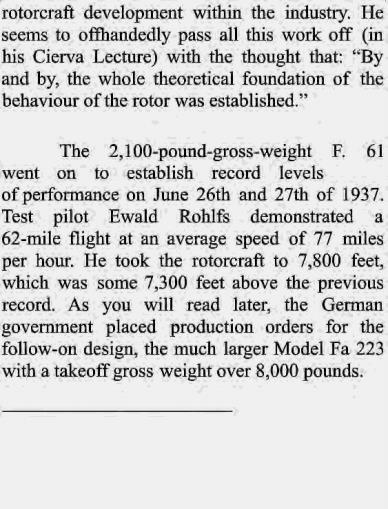
rotorcraft development within the industry.He seems to offhandedly pass all this work off (in his Cierva Lecture)with the thought that:"By and by,the whole theoretical foundation of the behaviour of the rotor was established." The 2,100-pound-gross-weight F.61 went on to establish record levels of performance on June 26th and 27th of 1937. Test pilot Ewald Rohlfs demonstrated a 62-mile flight at an average speed of 77 miles per hour.He took the rotorcraft to 7,800 feet, which was some 7,300 feet above the previous record.As you will read later,the German government placed production orders for the follow-on design,the much larger Model Fa 223 with a takeoff gross weight over 8,000 pounds
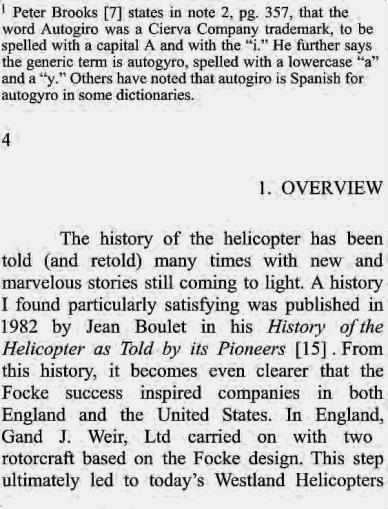
IPeter Brooks [7]states in note 2,pg.357,that the word Autogiro was a Cierva Company trademark,to be spelled with a capital A and with the "i."He further says the generic term is autogyro,spelled with a lowercase"a' and a"y."Others have noted that autogiro is Spanish for autogyro in some dictionaries. 1.OVERVIEW The history of the helicopter has been told (and retold)many times with new and marvelous stories still coming to light.A history I found particularly satisfying was published in 1982 by Jean Boulet in his History of the Helicopter as Told by its Pioneers [15].From this history,it becomes even clearer that the Focke success inspired companies in both England and the United States.In England, Gand J.Weir,Ltd carried on with two rotorcraft based on the Focke design.This step ultimately led to today's Westland Helicopters
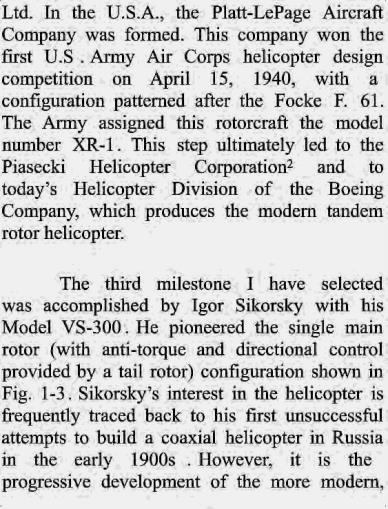
Ltd.In the U.S.A.,the Platt-LePage Aircraft Company was formed.This company won the first U.S.Army Air Corps helicopter design competition on April 15,1940,with a configuration patterned after the Focke F.61 The Army assigned this rotorcraft the model number XR-1.This step ultimately led to the Piasecki Helicopter Corporation2 and to today's Helicopter Division of the Boeing Company,which produces the modern tandem rotor helicopter. The third milestone I have selected was accomplished by Igor Sikorsky with his Model VS-300.He pioneered the single main rotor (with anti-torque and directional control provided by a tail rotor)configuration shown in Fig.1-3.Sikorsky's interest in the helicopter is frequently traced back to his first unsuccessful attempts to build a coaxial helicopter in Russia the early 1900s.However,it is the progressive development of the more modern
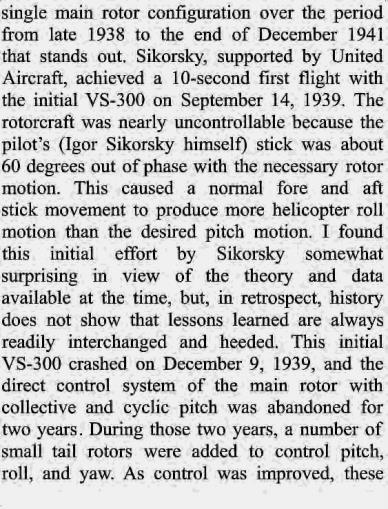
single main rotor configuration over the period from late 1938 to the end of December 1941 that stands out.Sikorsky,supported by United Aircraft,achieved a 10-second first flight with the initial VS-300 on September 14,1939.The rotorcraft was nearly uncontrollable because the pilot's (Igor Sikorsky himself)stick was about 60 degrees out of phase with the necessary rotor motion.This caused a normal fore and aft stick movement to produce more helicopter roll motion than the desired pitch motion.I found this initial effort t by Sikorsky somewhat surprising in view of the theory and data available at the time,but,in retrospect,history does not show that lessons learned are always readily interchanged and heeded.This initial VS-300 crashed on December 9,1939,and the direct control system of the main rotor with collective and cyclic pitch was abandoned for two years.During those two years,a number of small tail rotors were added to control pitch roll,and yaw.As control was improved,these
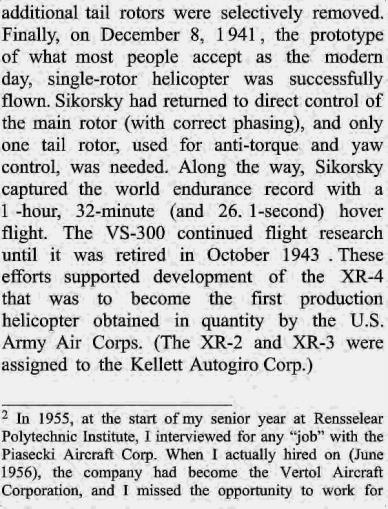
additional tail rotors were selectively removed Finally,on December 8,1941,the prototype of what most people accept as the modern day,single-rotor helicopter was successfully flown.Sikorsky had returned to direct control of the main rotor(with correct phasing),and only one tail rotor,used for anti-torque and yaw control,was needed.Along the way,Sikorsky captured the world endurance record with a I-hour,32-minute (and 26.1-second)hover flight.The VS-300 continued flight research until it was retired in October 1943.These efforts supported development of the XR-4 that was to become the first production helicopter obtained in quantity by the U.S Army Air Corps.(The XR-2 and XR-3 were assigned to the Kellett Autogiro Corp.) In 1955,at the start of my senior year at Rensselear Polytechnic Institute,I interviewed for any "job"with the Piasecki Aircraft Corp.When I actually hired on (June 1956),the company had become the Vertol Aircraft Corporation,and I missed the opportunity to )work for